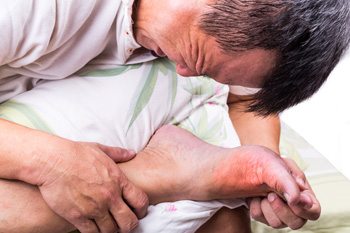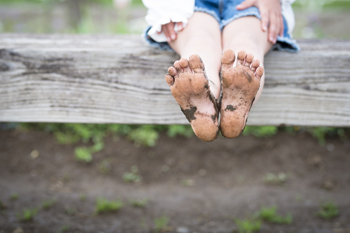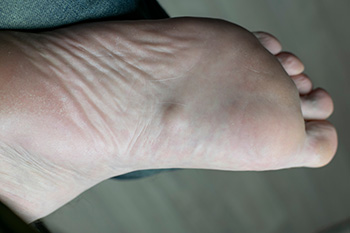Items filtered by date: December 2024
Choosing the Right Shoes for Walking and Running

Selecting the right shoes for walking and running is essential for comfort and injury prevention. For walking, look for shoes with proper arch support and cushioning to absorb impact during each step. A lightweight design with a flexible sole helps ensure natural movement. When choosing shoes for running, prioritize a snug fit surrounding the heel and midfoot with more flexibility in the toe area to accommodate the push-off phase. Running shoes should offer more cushioning and stability to handle the repetitive force of running. It is also important to consider the surface you will be walking or running on. Shoes for trail running need more grip and durability, while shoes for road running focus on cushioning. Finally, ensure that your shoes fit well, allowing room for toe movement but without excess space. If you have endured a foot injury from walking or running, it is suggested that you confer with a podiatrist who can treat various foot conditions, and guide you on correct walking or running shoes.
For more information about walking shoes versus running shoes, consult with one of our podiatrists from North Penn Podiatry. Our doctors can measure your feet to determine what your needs are and help you find an appropriate pair of footwear.
Foot Health: The Differences between Walking & Running Shoes
There are great ways to stay in shape: running and walking are two great exercises to a healthy lifestyle. It is important to know that running shoes and walking shoes are not interchangeable. There is a key difference on how the feet hit the ground when someone is running or walking. This is why one should be aware that a shoe is designed differently for each activity.
You may be asking yourself what the real differences are between walking and running shoes and the answers may shock you.
Differences
Walking doesn’t involve as much stress or impact on the feet as running does. However, this doesn’t mean that you should be any less prepared. When you’re walking, you land on your heels and have your foot roll forward. This rolling motion requires additional support to the feet.
Flexibility – Walking shoes are designed to have soft, flexible soles. This allows the walker to push off easily with each step.
If you have any questions, please feel free to contact our offices located in Lansdale, and King of Prussia, PA . We offer the newest diagnostic and treatment technologies for all your foot care needs.
Foot Ailments Can Be a Warning Signal

Foot ailments often signal underlying health issues that require attention. Conditions like dry, flaking skin on the feet might suggest fungal infections such as tinea, or could point to dermatitis conditions like eczema or psoriasis that are often linked to stress. Morning foot pain may result from wearing improper footwear or increased physical activity, but persistent pain could indicate more significant problems, like plantar fasciitis or other structural concerns. Cold feet might suggest poor circulation, which can have broader and more serious implications for vascular health. Clawed toes, commonly caused by wearing tight or pointy shoes, can also be associated with nerve damage or improper footwear sizing. Swollen feet, or edema, may result from poor venous circulation, indicating potential vascular or systemic health issues. A podiatrist can address underlying causes and recommend custom orthotics, footwear adjustments, or other treatment to improve your foot health. If you have unexplained foot or ankle issues, it is suggested that you schedule an appointment with a podiatrist for an exam and diagnosis.
Proper foot care is something many older adults forget to consider. If you have any concerns about your feet and ankles, contact one of our podiatrists from North Penn Podiatry. Our doctors can provide the care you need to keep you pain-free and on your feet.
The Elderly and Their Feet
As we age we start to notice many changes in our body, but the elder population may not notice them right away. Medical conditions may prevent the elderly to take notice of their foot health right away. Poor vision is a lead contributor to not taking action for the elderly.
Common Conditions
- Neuropathy – can reduce feeling in the feet and can hide many life-threatening medical conditions.
- Reduced flexibility – prevents the ability of proper toenail trimming, and foot cleaning. If left untreated, it may lead to further medical issues.
- Foot sores – amongst the older population can be serious before they are discovered. Some of the problematic conditions they may face are:
- Gouging toenails affecting nearby toe
- Shoes that don’t fit properly
- Pressure sores
- Loss of circulation in legs & feet
- Edema & swelling of feet and ankles
Susceptible Infections
Diabetes and poor circulation can cause general loss of sensitivity over the years, turning a simple cut into a serious issue.
If you have any questions please feel free to contact our offices located in Lansdale, and King of Prussia, PA . We offer the newest diagnostic and treatment technologies for all your foot and ankle needs.
Managing Nighttime Gout Flares

Nighttime gout flares often cause intense pain, swelling, and redness in the feet, and can severely disrupt sleep. Gout is a form of arthritis caused by a buildup of uric acid in the joints, and it frequently affects the big toe due to its susceptibility to stress and lower temperatures. Nighttime gout attacks may be linked to factors such as dehydration, reduced body temperature, and lower cortisol levels during sleep. These painful episodes can make it difficult for patients to find relief without medical help. A podiatrist can assess symptoms, confirm a diagnosis, and recommend strategies to reduce the frequency and severity of gout flares. These may include lifestyle modifications such as changes in diet, preventative techniques like weight loss, and treatments to alleviate pain and inflammation in the affected joints. Proper management not only helps to protect the health of your feet and ankles but also improves sleep patterns. If you have nighttime flare-ups of gout, it is suggested that you schedule an appointment with a podiatrist for guidance in managing this painful condition.
Gout is a foot condition that requires certain treatment and care. If you are seeking treatment, contact one of our podiatrists from North Penn Podiatry. Our doctors will treat your foot and ankle needs.
What Is Gout?
Gout is a type of arthritis caused by a buildup of uric acid in the bloodstream. It often develops in the foot, especially the big toe area, although it can manifest in other parts of the body as well. Gout can make walking and standing very painful and is especially common in diabetics and the obese.
People typically get gout because of a poor diet. Genetic predisposition is also a factor. The children of parents who have had gout frequently have a chance of developing it themselves.
Gout can easily be identified by redness and inflammation of the big toe and the surrounding areas of the foot. Other symptoms include extreme fatigue, joint pain, and running high fevers. Sometimes corticosteroid drugs can be prescribed to treat gout, but the best way to combat this disease is to get more exercise and eat a better diet.
If you have any questions please feel free to contact our offices located in Lansdale, and King of Prussia, PA . We offer the newest diagnostic and treatment technologies for all your foot and ankle needs.
Barefoot Walking in PreSchool Children

Allowing children to walk barefoot until the age of four is beneficial for both brain and body development. Walking without shoes promotes natural foot growth, helping to strengthen muscles and improve balance. It also enhances the sensory experience by allowing the feet to feel different textures and surfaces, which aids in the development of the brain’s sensory pathways. These early experiences help children develop coordination and spatial awareness, important skills for future movement. Barefoot walking also encourages proper posture and alignment, as the feet can move freely, engaging muscles that are vital for walking, running, and jumping. Furthermore, by spending time without shoes, children become more aware of their environment, improving their ability to navigate different terrains. If your child has a foot condition, it is suggested that you contact a podiatrist who can offer effective treatment solutions, and address any concerns you may have about your child walking barefoot.
The health of a child’s feet is vital to their overall well-being. If you have any questions regarding foot health, contact one of our podiatrists of North Penn Podiatry. Our doctors can provide the care you need to keep you pain-free and on your feet.
Tips for Keeping Children's Feet Healthy
- Make sure their shoes fit properly
- Look for any signs of in-toeing or out-toeing
- Check to see if they have Clubfoot (condition that affects your child’s foot and ankle, twisting the heel and toes inward) which is one of the most common nonmajor birth defects.
- Lightly cover your baby’s feet (Tight covers may keep your baby from moving their feet freely, and could prevent normal development)
- Allow your toddler to go shoeless (Shoes can be restricting for a young child’s foot)
- Cut toenails straight across to avoid ingrown toenails
- Keep your child’s foot clean and dry
- Cover cuts and scrapes. Wash any scratches with soap and water and cover them with a bandage until they’ve healed.
If you have any questions, please feel free to contact our offices located in Lansdale, and King of Prussia, PA . We offer the newest diagnostic and treatment technologies for all your foot care needs.
Wounds That Don't Heal Need to Be Checked
Risk Factors of Plantar Fibromas

Plantar fibromas are benign growths of fibrous tissue that develop within the plantar fascia, the thick band of tissue running along the sole of the foot. These firm nodules are often found in the arch and may cause discomfort, especially when walking or standing. The exact cause is unknown, but plantar fibromas may develop due to genetic predisposition, minor injuries, or repetitive stress on the foot. People with a family history or those with certain medical conditions, such as diabetes or liver disease, are more likely to experience them. Diagnosis involves a physical examination by a podiatrist, who may confirm the presence of fibromas with imaging tests like an ultrasound or MRI scans. Treatment options include custom orthotic inserts, corticosteroid injections, targeted exercises, and in severe cases, surgical removal. If you have symptoms of plantar fibroma, it is suggested that you schedule an appointment with a podiatrist for a proper diagnosis and treatment.
A plantar fibroma may disrupt your daily activities. If you have any concerns, contact one of our podiatrists of North Penn Podiatry. Our doctors can provide the care you need to keep you pain-free and on your feet.
Plantar Fibroma
A plantar fibroma is a fibrous knot in the arch of the foot. It is embedded in the plantar fascia which is a band of tissue that extends from the heel to the toes along the bottom of the foot. There can be multiple plantar fibromas in the feet at the same time. There are no known causes for this condition. If you have a plantar fibroma, there will be a bump in the arch of your foot that cannot be missed. Any associated pain is most often due to a shoe rubbing against the nodule. Non-surgical options, such as steroid injections, physical therapy, and orthotics should be tried first. Surgery is a last resort and is the only thing that will remove a plantar fibroma entirely. Consult with a podiatrist for a proper diagnosis and to determine the treatment regimen that is right for you.
What Causes a Plantar Fibroma?
While there are no specific causes identified, a plantar fibroma can possibly come from genetic predisposition or the formation of scar tissue that forms from healing the tears in the plantar fascia.
What Are the Symptoms of a Plantar Fibroma?
There will be a noticeable lump in the arch of the foot that may or may not cause pain. If pain is felt, it is typically because a shoe is rubbing up against the lump or when walking or standing barefoot.
Treatment and Prevention
A plantar fibroma will not disappear without treatment, but it can get smaller and be a non-issue. If pain persists, a podiatrist examines the foot and when the arch of the foot is pressed, pain can be felt down to the toes. An MRI or biopsy might be performed to help diagnose or evaluate the plantar fibroma. The following non-surgical options are generally enough to reduce the size and pain of these nodules:
- Steroid injections
- Orthotics
- Physical therapy to help apply anti-inflammatory creams on the bump
Surgery is considered if the mass increases in size and the patient continues to feel pain after non-surgical methods are tried.
If you have any questions please feel free to contact our offices located in Lansdale, and King of Prussia, PA . We offer the newest diagnostic tools and technology to treat your foot and ankle needs.

